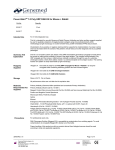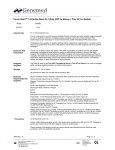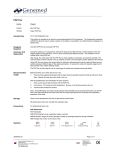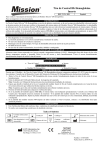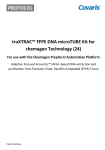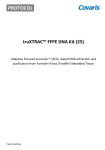Download Power-StainTM 2
Transcript
______________________________________________________________________________ Power-StainTM 2.0 Kit Poly HRP for Mouse + Rabbit Cat No. Quantity 52-0006 15 mL Ready-To-Use 54-0006 100 mL Ready-To-Use Intended Use For In Vitro Diagnostic Use. This kit is intended for use with Mouse and/or Rabbit Primary Antibody and other ancillary reagents supplied by user for qualitative detection of targeted protein (antigen) using immunohistochemistry (IHC) methodology by light microscopy on routine formalin-fixed, paraffin-embedded (FFPE) tissue section. Interpretation of any positive or negative staining shall be supported by implementation of a proper control, and must be made within the context of the patient’s clinical history and other diagnostic test by a qualified pathologist. Summary And Explanation This kit is a non-biotin system and utilizes linker to locate where the mouse and/or rabbit primary antibody is bound to the target antigen. Poly HRP (horseradish peroxidase) conjugate is then applied and binds to the linker. This complex is observed through the use of a substrate-chromogen solution, which when added, results in a colored precipitate at the antigen location. The staining location and pattern is easily observable by light microscopy. Reagents Supplied Reagent A: One bottle of ready-to-use Linker for Mouse + Rabbit Anibody in Tris Buffer containing stabilizing proteins and 0.09% Sodium Azide. Reagent B: One bottle of ready-to-use Poly HRP Conjugate for Mouse + Rabbit in Tris Buffer containing stabilizing proteins and anti-microbial agents. Storage Store at 2-8°C. Do not freeze. All performance claims are void after the kit expiration date. Materials Required But Not Supplied Primary Antibody (Genemed offers prediluted and concentrate Primary Antibodies that are Ready-To-Use and optimized with Power-StainTM 2.0 Kit Poly HRP for Mouse + Rabbit and Acu-StainTM Kits) Primary Antibody Diluent (Cat No. 10-0001) Reagent Control (Non-immune Mouse IgG Cat No. 60-0045 and Non-Immune Rabbit IgG Cat No. 60-0060) Positive and Negative Control Specimens Microscope Slides, Positively Charged Xylene Ethanol Endogenous Peroxidase Blocking Solution - 3% Hydrogen Peroxide Wash Buffer - 10 mM Phosphate Buffer Saline, pH 7.4; optional with 0.05% Tween 20 HRP Substrate/Chromogen Reagents – AEC Substrate (Cat No. 10-0005) – DAB Substrate (Cat No. 10-0006) Hematoxylin (Cat No. 10-0027) Antigen retrieval reagents (e.g. Cat No. 10-0022 Citrate Buffer pH 6.0 1X; Cat No. 10-0020 Citrate Buffer pH 6.0 20X; Cat No. 10-0024 Proteinase K) Precautions For professional users only. Proper handling of this product as with any product derived from biological sources should be used according to local and applicable regulations. Sodium azide (NaN 3 ) is a toxic chemical and is present as an antimicrobial agent in Reagent A. The concentration in these products is not classified as hazardous. However, the build-ups of sodium azide may react with lead and copper plumbing to form highly explosive metal azides. Flush any disposed reagent with large volume of water to prevent azide build-up. 30335 Rev.04 Page 1 of 4 Genemed Biotechnologies, Inc 458 Carlton Ct. South San Francisco, CA 94080, U.S.A. Tel: 650-952-0110 Fax: 650-952-1060 MDSS GmbH Schiffgraben 41 30175 Hannover Germany ______________________________________________________________________________ Sodium azide inhibits peroxidase activity. Use caution when handling HRP conjugate (Reagent B) to prevent any contamination with other reagents containing sodium azide. Procedural Notes The reagents for this kit have been designed to be Ready-To-Use. Any dilutions or alterations of the kit reagents may give erroneous staining results. The directions accompanying this kit provide step by step instructions for optimal staining. Any change in procedure or incubation times may give erroneous staining results. All reagents should be allowed to equilibrate at room temperature readily before usage. All incubations should be performed at room temperature in a humid environment. Do not allow the tissue section to dry out at any point in the staining procedure. The reagents are for single use. Preliminary Preparation Of Slides Routine de-paraffinization and rehydration of tissue section. Control Slides Three types of control slides are necessary for proper interpretation. Antigen retrieval as required by the primary antibody. Positive Tissue Control – A tissue containing the desired antigen. Negative Tissue – A tissue that does not contain the desired antigen. Reagent Control – A slide to be treated with a homologous non-immune immunoglobulin. (Cat No. 60-0045 or Cat No. 60-0060) Staining Protocol Step 1: Endogenous Peroxidase Blocking a) Submerge slides in Peroxidase Blocking Solution for 10 minutes. b) Wash slides with Wash Buffer to remove excess Peroxidase Blocking Solution. c) Tap off excess liquid and carefully wipe around tissue. Step 2: Primary Antibody Incubation a) Prepare Primary Antibody to optimum concentration. If necessary, dilute with Primary Antibody Diluent. b) Add 2 drops (100 µL) or as much as needed of Primary Antibody to completely cover each tissue. c) Incubate for 30-60 minutes. d) Rinse 3 times with Wash Buffer for 2 minutes each. e) Tap off excess liquid and carefully wipe around tissue. Step 3: Linker for Mouse + Rabbit Antibody Incubation (Reagent A) a) Add 2 drops (100 µL) or as much as needed of Linker to completely cover each tissue. b) Incubate for 15 ± 1 minutes. c) Rinse 3 times with Wash Buffer for 2 minutes each. d) Tap off excess liquid and carefully wipe around tissue. Step 4: Poly HRP Conjugate Incubation (Reagent B) a) Add 2 drops (100 µL) or as much as needed of Enzyme Conjugate to completely cover each tissue. b) Incubate for 15 ± 1 minutes. c) Rinse 3 times with Wash Buffer for 2 minutes each. d) Tap off excess liquid and carefully wipe around tissue. Step 5: Substrate/Chromogen a) Perform Substrate/Chromogen incubation according to manufacturer’s instruction. Step 6: Counterstaining a) Counterstain with Hematoxylin according to manufacturer’s instruction. 30335 Rev.04 Page 2 of 4 Genemed Biotechnologies, Inc 458 Carlton Ct. South San Francisco, CA 94080, U.S.A. Tel: 650-952-0110 Fax: 650-952-1060 MDSS GmbH Schiffgraben 41 30175 Hannover Germany ______________________________________________________________________________ Step 7: Mounting a) Interpretation Of Staining Results Mount and coverslip the specimen with appropriate mounting solution based on Substrate/Chromogen used. Step 1: Review Positive and Negative Controls. Do not proceed to next step if the staining intensity does not meet requirements. Step 2: Score the tested specimens. Positive Negative Control Control Tissue Tissue 1 + 2 + Troubleshooting Reagent Control Test Tissue Analysis of Result -- -- + Specimen contains the antigen -- -- -- Reagent Control Test Tissue Analysis of Result Specimen does not contain the antigen Positive Negative Control Control Tissue Tissue 1 -- -- -- -- No staining 2 Weak + -- -- +/- Weak staining 3 + + + + High background staining Possible causes and suggested action for: No staining on any slide 1. Reagents not used in correct order. Repeat procedure following Staining Protocol Instructions. 2. Substrate-Chromogen reagent not prepared properly. Prepare a fresh Substrate-Chromogen solution following the instructions included with the product. 3. Primary antibody incubation steps were omitted or dilution was incorrect or wrong antibody was used. Repeat procedure following Staining Protocol Instructions using incubation times specified. Repeat procedure using correct dilution for primary antibody or correct primary antibody. 4. Wrong Pretreatment. Repeat procedure using correct pretreatment. Possible cause and suggested action for: Weak staining on all slides 1. Substrate-Chromogen reagent has expired. Prepare a fresh Substrate-Chromogen solution following the instructions included with the product. 2. Incubation times were not long enough. Repeat procedure following Staining Protocol Instructions using incubation times specified. 3. Specimen retained too much liquid after rinsing steps. Tap off excess liquid and carefully wipe around specimen after rinsing steps. 4. Peroxidase Enzyme Conjugate (Reagent B) exposed to Sodium Azide. Use buffer without Sodium Azide, or check if Reagent B is contaminated with Sodium Azide during use or aliquot/pipetting. 5. Primary antibody dilution was incorrect. Repeat procedure following Staining Protocol Instructions using incubation times specified. 6. Insufficient Pretreatment. Repeat procedure using correct pretreatment. 30335 Rev.04 Page 3 of 4 Genemed Biotechnologies, Inc 458 Carlton Ct. South San Francisco, CA 94080, U.S.A. Tel: 650-952-0110 Fax: 650-952-1060 MDSS GmbH Schiffgraben 41 30175 Hannover Germany ______________________________________________________________________________ Possible cause and suggested action for: High background staining on all slides 1. Specimens contain high endogenous peroxidase activity. Check preparation of Peroxidase Solution and verify timing of specimens submerged in solution. 2. Inadequate rinsing of slides. Use freshly prepared buffer solutions. Follow rinsing instructions specified. 3. De-paraffinization not complete. Use fresh xylene. Check slides are de-paraffinized before rehydration step. 4. Over-reaction of substrate. Do not incubate substrate longer than specified in procedure. 5. Specimens dry out during staining procedure. Incubate in humid environment. Wipe fewer than 10 slides at a time before adding next solution. 6. Wrong Pretreatment. Repeat procedure using correct pretreatment. Symbols Catalog No. 30335 Rev.04 Batch No. In Vitro Diagnostic Use Temperature Range Use By Page 4 of 4 Genemed Biotechnologies, Inc 458 Carlton Ct. South San Francisco, CA 94080, U.S.A. Tel: 650-952-0110 Fax: 650-952-1060 MDSS GmbH Schiffgraben 41 30175 Hannover Germany





